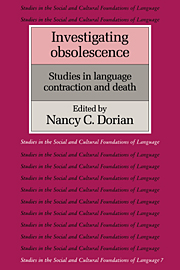Book contents
- Frontmatter
- Contents
- List of maps
- List of contributors
- Preface
- Map
- Dedication
- Introduction
- I Focus on context
- II Focus on structure
- 11 Problems in obsolescence research: The Gros Ventres of Montana
- 12 The structural consequences of language death
- 13 On signs of health and death
- 14 Case usage among the Pennsylvania German sectarians and nonsectarians
- 15 Estonian among immigrants in Sweden
- 16 The incipient obsolescence of polysynthesis: Cayuga in Ontario and Oklahoma
- 17 Urban and non-urban Egyptian Nubian: Is there a reduction in language skill?
- 18 Some lexical and morphological changes in Warlpiri
- 19 Language contraction and linguistic change: The case of Welland French
- 20 Lexical innovation and loss: The use and value of restricted Hungarian
- III Invited commentaries
- Bibliography
- Index of languages
- General index
19 - Language contraction and linguistic change: The case of Welland French
Published online by Cambridge University Press: 08 January 2010
- Frontmatter
- Contents
- List of maps
- List of contributors
- Preface
- Map
- Dedication
- Introduction
- I Focus on context
- II Focus on structure
- 11 Problems in obsolescence research: The Gros Ventres of Montana
- 12 The structural consequences of language death
- 13 On signs of health and death
- 14 Case usage among the Pennsylvania German sectarians and nonsectarians
- 15 Estonian among immigrants in Sweden
- 16 The incipient obsolescence of polysynthesis: Cayuga in Ontario and Oklahoma
- 17 Urban and non-urban Egyptian Nubian: Is there a reduction in language skill?
- 18 Some lexical and morphological changes in Warlpiri
- 19 Language contraction and linguistic change: The case of Welland French
- 20 Lexical innovation and loss: The use and value of restricted Hungarian
- III Invited commentaries
- Bibliography
- Index of languages
- General index
Summary
Community profile
French settlement
The city of Welland, Ontario is located in the heart of the Niagara Peninsula close to the famous falls of the same name. The story of its French community is that of practically all communities of the French-Canadian diaspora. The exodus of French Canadians beyond the borders of the province of Quebec (the principal stronghold of the French language in North America) was essentially touched off by rural overpopulation, forcing many to leave their old settled parishes in search of manual work in the developing urban industrial centers of Ontario to the west and New England to the south. Although the initial migration of French Canadians from Quebec to Ontario dates back to the early nineteenth century, the origins of Welland's French-speaking minority are more recent, since they can only be traced back to the turn of this century. Welland's industries (chiefly textile mills, iron and steel factories, and rubber plants) were spurred by the outbreak of World War I, creating many new, well-paid jobs which were to attract, by 1919, around forty French-Canadian families from Quebec. These families may be considered the historical kernel of the French-speaking community of Welland. They settled in the eastern half of the city where the industrial plants were located, an area which was soon to be known as “Frenchtown”. By the end of the 1940s, however, social mobility had brought about some residential dispersion.
As an industrial center, Welland was hit hard by the great Depression, which saw the departure of numerous francophone families.
- Type
- Chapter
- Information
- Investigating ObsolescenceStudies in Language Contraction and Death, pp. 287 - 312Publisher: Cambridge University PressPrint publication year: 1989
- 18
- Cited by



